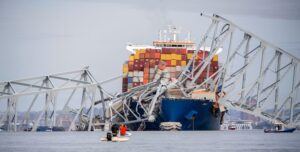
By Richard Ofori BOATENG
The recent collision of the container ship Dali with the Francis Scott Key Bridge in Baltimore has not only caused a structural catastrophe but also sent ripples through the insurance sector, project management spheres, and the global supply chain. Investigations into the incident that occurred on Tuesday, March 26, 2024, are likely to take up to two years to complete, according to National Transportation Safety Board Chair Jennifer Homendy.
This incident has a multifaceted impact spanning several industries, but this article looks at the impact on the areas of insurance, supply chains, and project management.
Insurance: The incident underscores the intricate web of insurance coverages that will come into play, highlighting the need for robust risk assessment and insurance strategies in the maritime and transportation industries. Claims are expected to focus on protection & indemnity (P&I), property damage, marine hull, marine cargo, and business interruption among others.
The incident will likely lead to a surge in claims with the International Group of P&I Clubs expected to absorb the majority of the losses. According to Marine Insurance Claims experts, the incident could become the largest marine insured loss ($1.5 billion – $3 billion) surpassing the Costa Concordia disaster’s $1.5billion loss in 2012.

This event underscores the growing risks associated with modern maritime operations challenging (re)insurers to reassess risk management strategies and policy premiums (especially marine reinsurance pricing) in the face of such unforeseen disasters. As the industry grapples with these challenges, collaboration between insurers, reinsurers, and policymakers will be crucial to enhance the resilience of the maritime sector and protect the global supply chain from similar disruptions in the future.
Supply Chains: The supply chain impact is profound and could be far-reaching as it may affect other regional and national economies. The Port of Baltimore is a pivotal node for automobile freight and other commodities such as sugar and coal. The halt in the port’s operations will have a major impact on the supply chain creating a bottleneck as many ships have been left in limbo. It is expected to cause a delay in the movement of goods and could shift cargo traffic to other ports as some major ocean carriers have had to divert their cargo to other ports.
A CNBC news report indicates that “MSC, the largest ocean carrier in the world, has joined the list of ocean carriers terminating the delivery of diverted containers outside of the port for shipping clients” and as a result placing the responsibility of “cargo pick up at a diverted port and transport to its final destination on the shipper”. This incident serves as a stark reminder of the fragility of our supply networks and the need for diversified logistic strategies to mitigate the consequences of such disruptions.
Project Management: This incident serves as a reminder of the importance of proper risk management strategies in the practice of modern-day project management. The collapse of the bridge highlights the critical need for robust risk assessment and innovative risk mitigation plans to ensure projects meet current standards.
In a report by CNN, the National Transportation Safety Board Chair Jennifer Homendy is reported to have said that the Francis Scott Key Bridge in Baltimore did not have any redundancy, which is included in the preferred method of building bridges in the present day. According to her, “the bridge is a fracture critical,” meaning if a portion fails, that will cause another portion of or the entire structure to fail. This catastrophic event will prompt project managers to intensify their focus on safety standards and emergency preparedness. It also highlights the need for project managers to be agile, adaptable, and equipped with contingency plans to address unforeseen disruptions.
This event will shape future policies and practices across multiple sectors, emphasizing the interconnected nature of our modern trade and economies. The aftermath of this incident is expected to lead to a re-evaluation of risk management strategies and protocols amongst professionals in various sectors since the implications extend beyond the immediate damage and affect their operations and the broader economic landscape.









